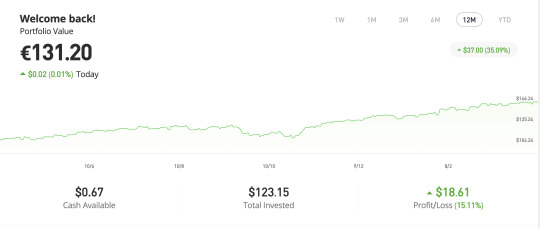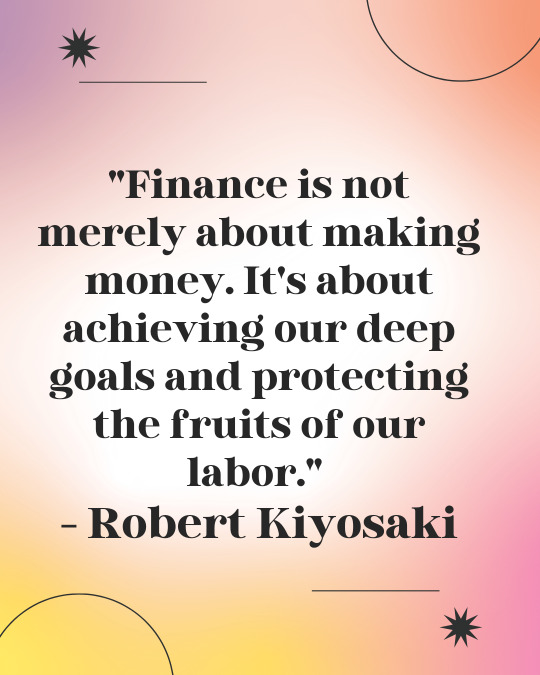#Financial Education
Text
Time gone never returns.

#financial freedom#financial literacy#moneyquotes#personal finance#budgeting#finance#money mindset#money management#financial education#happylife#moneytips#financial independence#financial tips#financialfreedom
110 notes
·
View notes
Text
Mastering the Art of Investing: Practical Strategies for Insightful Decision-Making
Key Point:
Making smart and insightful investment decisions is an attainable goal with the right strategies in place. By recognizing your limitations, managing emotions, seeking professional guidance, and aligning your investments with personal objectives, you can cultivate a robust and successful investment portfolio that stands the test of time.
Sound investment decisions are the bedrock of financial success. However, navigating the complex world of investing can be challenging, even for the most seasoned investors. This post explores practical strategies for making smart and insightful investment decisions, empowering you to grow your wealth with confidence and finesse.
Recognize the Limits of your Abilities
In both life and investing, it is crucial to acknowledge the boundaries of our expertise. Overestimating our abilities can lead to ill-advised decisions and, ultimately, financial losses. By cultivating humility and seeking external guidance when necessary, we can minimize risks and make more informed investment choices.
Manage Emotional Influence on Decision-Making
Emotions can significantly impact our ability to make rational decisions. To circumvent the sway of emotions, adopt a disciplined approach to investing, relying on data-driven analysis and long-term strategies rather than succumbing to impulsive reactions.
Leverage the Expertise of an Advisor
Engaging a professional financial advisor is a prudent investment decision. Their wealth of knowledge and experience can help you navigate market complexities and identify opportunities tailored to your financial goals, risk tolerance, and investment horizon.
Maintain Composure Amidst Market Volatility
Periods of market turbulence can incite panic among investors. However, it is essential to remain level-headed and maintain a long-term perspective during such times. Avoid making impulsive decisions based on short-term fluctuations and focus on your overarching financial objectives.
Assess Company Management Actions Over Rhetoric
When evaluating potential investments, examine the actions of a company's management rather than relying solely on their statements. This approach ensures a more accurate understanding of the organization's performance, financial health, and growth prospects.
Prioritize Value Over Glamour in Investment Selection
The most expensive investment options are not always the wisest choices. Focus on identifying value rather than being swayed by glamorous or high-priced options. This strategy promotes long-term financial growth and mitigates the risk of overpaying for underperforming assets.
Exercise Caution with Novel and Exotic Investments
While unique and exotic investment opportunities may appear enticing, approach them with caution. Ensure thorough research and due diligence before committing to such investments, as they may carry higher risks and potential pitfalls.
Align Investments with Personal Goals
Invest according to your individual objectives rather than adhering to generic rules or mimicking the choices of others. Personalized investment strategies are more likely to yield favorable results, as they account for your unique financial circumstances, risk appetite, and long-term aspirations.
Making smart and insightful investment decisions is an attainable goal with the right strategies in place. By recognizing your limitations, managing emotions, seeking professional guidance, and aligning your investments with personal objectives, you can cultivate a robust and successful investment portfolio that stands the test of time.
Action plan: Learn a few simple rules and ignore the rest of the advice you receive.
It’s easy to become completely overwhelmed by the volume of advice available about investing. However, you don’t need to become an expert on the stock market in order to become a good investor.
Just like an amateur poker player can go far if he simply learns to fold his worst hands and bet on his best ones, a novice investor can become very competent just by following a few simple rules. For example, he should learn not to overreact to dips in the market and make sure to purchase value stocks instead of glamour stocks.
#Financial freedom#Building wealth#Personal finance strategies#Investment advice#Passive income stream#Early retirement planning#Debt reduction#Budgeting tips#Saving money#Wealth management#Financial independence#Secure financial future#Retirement planning#Financial planning#Personal finance#Money management#Investment strategies#Retirement savings#Investment portfolio#Financial education#Wealth creation#Financial goals#Wealth building#Financial security#Retirement income#Passive income ideas#Financial advice#Financial wellness#Financial planning tools#Financial management
28 notes
·
View notes
Text
Mastering Personal Finance and Investing: Your Ultimate Guide to Financial Freedom
Introduction: Understanding the Importance of Personal Finance and Investing
Personal Finance and Investing: Your Path to Financial Freedom
Importance of Personal Finance and Investing for Wealth Creation
The Basics of Personal Finance: Budgeting, Saving, and Debt Management
Mastering the Basics: Budgeting, Saving, and Debt Management
Budgeting Tips for Effective Personal Finance…
View On WordPress
#personal finance#financial planning#money management#budgeting#savings#debt management#investing#wealth creation#retirement planning#401(k)#IRA#stock market#real estate investing#compound interest#tax planning#financial freedom#financial education#money tips#financial goals#investment strategies#financial literacy#wealth management#financial advice#financial independence#money mindset#financial success
20 notes
·
View notes
Text
7 Success Sabotaging Habits You Need to Ditch
Written by Delvin
Success is often hindered by self-sabotaging habits that we may not even be aware of. In this post, we’ll explore seven common habits that can derail your path to success and provide strategies to overcome them.
1. Procrastination: Putting off important tasks can prevent you from reaching your goals. Combat procrastination by breaking tasks into smaller, manageable steps and…
View On WordPress
#Breaking Bad Habits#dailyprompt#Financial#Financial Education#Financial Literacy#knowledge#money#Money Habits#Personal Development#Personal Finance#Success Habits
3 notes
·
View notes
Text
the beginner's guide to making money by investing in stocks (hot girl version)
since one of my goals here is to make money i wanted to teach you about what i know about investing in stocks. i use the website etoro to invest, below you can see a picture of my portfolio at the moment. i am by no means an expert but i've found the whole process of investing to be unnecessarily mystified so i thought i'd share what i have learned so far.

what does buying stocks mean?
in simple terms, buying stocks means buying a (tiny) fraction of a company. if the value of the company increases the value of your share goes up, if the company loses money the value goes down.
when should i buy and sell?
ideally, you should buy when you think that the value of a stock will increase in the future and you should sell when you have made a profit. in practice, this means you try to invest when a stock has reached its lowest value and you sell when you think it has reached its peak (but this is, of course, impossible to predict perfectly).
where can i buy stocks?
i would personally recommend going through an online stock trading platform, like etoro. you can look up what the best stock trading platforms are for your country. you should pick one with minimal fees that offers some tutorial or introduction to trading.
you can also go through a stock broker (a person that makes the investments for you) or more broadly your bank - be aware though, that they might take a cut of your profit for their services which is something you need to subtract from your expected profit.
how do i know what to invest in?
There are a few recommendations that I have seen time and time again:
ETFs - exchange-traded funds are bundles of stocks that are traded together. the advantage of ETFs is that they don't rely on a single company making a profit, the companies just need to make a profit overall. they are much less volatile than individual stocks and since economies usually always grow in the long-term, you are very likely to make a profit.
large companies - you can also invest in large, well-established companies that are very likely to make a profit and very unlikely to go bankrupt (e.g., apple, amazon, etc.)
diversify - this means you should invest in a wide variety of companies and industries. even when one of them does really poorly you are likely to make a profit overall.
copy-trading - this means 'copying' the investments of a more experienced trader. so you specify an amount of money and invest it the same way someone who knows what they're doing is.
how much should i invest?
most websites have a minimum amount you need to invest so you could start with that to get a feel for how it works.
as a rule of thumb, they say you should not invest money that you will need within the next 5-10 years. that rule prevents you from having to sell your stock at an unfortunate moment - even if you initially write losses, you can wait for a moment when your stocks have increased in value again.
if you have a fixed income you can commit to investing a part of your income every month. i've seen this referred to as dollar-cost averaging and i have not tried it yet but it is said to be a good way to build wealth in the long term.
how do i actually make money using this knowledge?
simple answer: by selling your stock at the right time and withdrawing the money. investing is a marathon, not a sprint - you should generally give your money some time to make a profit instead of checking every day and panic selling when you see a slight change. disclaimer: at least where i am from you need to declare what you made from stocks as income and pay taxes on it.
thank you so much for reading!
if you have questions or know more about this and want to add something please leave a comment 💕
#financial freedom#law of assumption#stock trading#financial empowerment#financial education#neville goddard#manifesting money#manifestation#rich girl
6 notes
·
View notes
Photo

#Iconoclast - Robert Kiyosaki
Robert grew up in the small town of Hilo, Hawaii. He went to college at Kings Point Merchant Marine Academy in New York state. Upon graduation, Robert turned down a well-paying job with Standard Oil and chose to enlist in the Marine Corps as a helicopter pilot at the time of the Vietnam War.
#Gentlemans Code#iconoclast#icon#financial education#finance#rich dad poor dad#rich dad education#hawaii#USA#investing#real estate#robert kiyosaki#entrepreneur#entrepreneurship#money#teacher
8 notes
·
View notes
Text
Bruh how tf do finances work
#financial education#trying to gain financial literacy is looking at smth and going 'I don't recognise a single word from this sentence'#I'm trying to do it because woohoo set yourself up with a stable future but like bruh it's so painful
3 notes
·
View notes
Text
The Wealth Gap: Why 98% of People Aren't Wealthy
Title: The Wealth Gap: Why 98% of People Aren’t Wealthy
I have found due to over 30 years of studying Personal Development that, All successful people know that their success is due to 95% personal development/mindset, and 5% focused action. It is not the ���thing” that creates success, it’s You. Your success is in direct correlation to your level of Personal Development and the action you…
View On WordPress
#Debt accumulation#Financial education#Financial Literacy#Income disparities#Investment knowledge#Lifestyle inflation#procrastination#Savings#Wealth#Wealth gap
4 notes
·
View notes
Text
Had someone (late teens) confuse a 401k with health Insurance. Theirs a reason they don't teach money management and how to handle finances in school. They make more money on the ignorance of people than the education of others.
4 notes
·
View notes
Text
youtube
#How to#10 secrets to achieve financial success#how to achieve financial freedom#financial freedom#financial education#financial success#how to achieve financial goals#financial literacy#how to achieve financial success#how to get rich#financial independence#how to achieve financial stability#success#secrets to success#simple steps to financial freedom#10 money rules for financial success#Youtube
2 notes
·
View notes
Text
7 Reasons to Create Cash Flow with the Stock Market
Seven reasons to use and create cash Flow with the stock market Have you ever thought about retiring and Not having to worry about money anymore Most people consider retirement as the Time when they no longer have to work However for some retirements may never Come due to a lack of savings or their Savings being too small due to inflation Using cash flow to retire is an Alternative that grows…

View On WordPress
#andy tanner#business ideas#cash flow#cashflow game#financial education#financial literacy#how to get rich#how to invest#how to make money#how to make passive income#investing for beginners#kiyosaki#make money#motivational speakers#network marketing#passive income#reasons to cash flow the stock market#rich dad poor dad#robert#Robert Kiyosaki#stock market cash flow#stock market cash flow andy tanner
8 notes
·
View notes
Text

#finance#moneyquotes#personal finance#financial literacy#financial freedom#financial education#budgeting#financial tips#money mindset#wealth
75 notes
·
View notes
Text
How to Work Less to Achieve More
Key Point:
keep your attention on an important task by adopting hyperfocus. When you hyperfocus, you rid your environment of distractions, and become aware of what’s occupying your mind. What’s more, every time your attention strays, redirect it. Remember is that scatterfocus can help you with tricky problems that require creative solutions. With scatterfocus, you allow the mind to wander and make unusual connections. You can help create scatterfocus by nourishing your mind and allowing time to reflect.
In our fast-paced world, working long hours has become the norm. However, the key to achieving more is not simply working harder or longer—it's about working smarter. In this article, we will explore strategies to help you work less while accomplishing more. By training yourself to enjoy hyperfocus, cultivating meta-awareness and intentional focus, eliminating distractions, harnessing the power of scatterfocus for creative thinking, connecting seemingly unrelated information, and nourishing your mind, you can optimize your productivity and achieve greater success.
Train yourself to enjoy hyperfocus more.
Hyperfocus is a state of intense concentration where you become fully immersed in a task or activity. To work less and achieve more, it's important to train yourself to enjoy and leverage hyperfocus. Set clear goals, break tasks into manageable chunks, and eliminate distractions. Engage in activities that naturally captivate your attention and give you a sense of fulfillment. By training yourself to enjoy hyperfocus, you can maximize productivity and accomplish more in less time.
Meta-awareness and intentional focus are key to managing your attention.
Meta-awareness refers to being aware of your own thoughts and mental processes. Intentional focus involves directing your attention consciously and purposefully. Cultivating these skills is essential for effective attention management. Develop the ability to notice when your mind starts to wander and gently bring your focus back to the task at hand. By practicing meta-awareness and intentional focus, you can reduce time wasted on distractions and stay on track to achieve your goals.
Achieve hyperfocus by ridding your environment of distractions.
Distractions can significantly impact productivity and hinder your ability to work efficiently. Create a conducive work environment by minimizing distractions. Turn off notifications on your phone, close unnecessary browser tabs, and create a physical workspace that promotes focus. Consider using productivity tools or apps that block or limit access to distracting websites or applications. By eliminating external distractions, you can enter a state of hyperfocus and accomplish more in less time.
Scatterfocus helps you plan and think creatively.
Scatterfocus is the practice of intentionally allowing your mind to wander and explore different ideas, without a specific goal or objective. This mental state can be beneficial for planning and creative thinking. Set aside dedicated time for scatterfocus, allowing your mind to freely explore different thoughts and possibilities. Embrace daydreaming, engage in activities that stimulate your imagination, and give yourself permission to think outside the box. By incorporating scatterfocus into your work routine, you can generate fresh ideas and enhance your problem-solving skills.
Use scatterfocus to connect the dots between seemingly unrelated bits of information.
One of the unique benefits of scatterfocus is its ability to facilitate connections between seemingly unrelated information. During moments of scatterfocus, your mind can make unexpected connections and insights. Capture these ideas by carrying a notebook or using a note-taking app to jot down your thoughts. When you revisit these notes later, you may discover valuable connections and insights that can fuel your productivity and lead to innovative solutions.
Nourish your mind to make the most of scatterfocus.
To optimize scatterfocus and enhance your overall productivity, it's important to nourish your mind. Engage in activities that promote mental well-being, such as regular exercise, quality sleep, and mindfulness practices. Take breaks throughout the day to recharge and refresh your mind. Additionally, fuel your brain with nutritious foods that support cognitive function, such as fruits, vegetables, whole grains, and omega-3 fatty acids. By prioritizing self-care and nourishing your mind, you can maximize the benefits of scatterfocus and achieve more with less effort.
Working less while achieving more is within your reach. By training yourself to enjoy hyperfocus, cultivating meta-awareness and intentional focus, eliminating distractions, harnessing the power of scatterfocus for creative thinking, connecting seemingly unrelated information, and nourishing your mind, you can optimize your productivity and achieve greater success. Remember, it's not about working longer hours, but about working smarter. Embrace these strategies, experiment with different techniques, and find the balance that works best for you. As you implement these practices, you'll discover the power of effective attention management and witness your productivity soar.
Action Plan: Have a cup of coffee to help you hyperfocus.
Caffeine and hyperfocus are a match made in heaven. Caffeine keeps you alert and focused. It helps you persevere when work gets boring. And perhaps most importantly, it can improve your performance on a number of cognitive tasks. So the next time you need a burst of intense concentration, make sure you’ve got a cup of coffee to hand – if nothing else, it tastes wonderful.
#Financial freedom#Building wealth#Personal finance strategies#Investment advice#Passive income stream#Early retirement planning#Debt reduction#Budgeting tips#Saving money#Wealth management#Financial independence#Secure financial future#Retirement planning#Financial planning#Personal finance#Money management#Investment strategies#Retirement savings#Investment portfolio#Financial education#Wealth creation#Financial goals#Wealth building#Financial security#Retirement income#Passive income ideas#Financial advice#Financial wellness#Financial planning tools#Financial management
12 notes
·
View notes
Text
Master Your Finances: 10 Proven Strategies for Financial Freedom
Financial success is a dream that many people aspire to achieve. Whether it’s the desire to retire comfortably, provide for your family, or simply enjoy a worry-free life, mastering your finances is essential. But achieving financial freedom is not a matter of luck; it requires careful planning, discipline, and the implementation of proven strategies. In this blog, we will explore ten strategies…

View On WordPress
#saving and investing#income growth#money#wealth protection#wealth#money protection#debt management#discipline and patience#emergency fund#how to achieve financial freedom#financial independence#financial goals#money tips#personal finance#budgeting#financial education#financial management#wealth building#lifestyle inflation
2 notes
·
View notes
Text
5 Essential Ways to Set Yourself Up for Financial Success
Written by Delvin
Achieving financial success is a goal many of us aspire to, but it often requires deliberate planning and consistent action. Whether you’re looking to build wealth, become debt-free, or simply gain financial peace of mind, there are fundamental steps you can take to set yourself up for success. Here are five essential strategies to help you on your path to financial…
View On WordPress
#5 Essential Ways to Set Yourself Up for Financial Success#dailyprompt#Financial#Financial Education#Financial Literacy#Invest#knowledge#Personal Finance
2 notes
·
View notes
Text
Candlestick Charting: A Tale of Tradition and Innovation from Japan
Candlestick charting's rich origins in Japan reveal timeless insights into market sentiment. Embrace the past's wisdom as we navigate today's markets, confident that understanding emotions will illuminate brighter trading paths! 🚀📈 #FinancialWisdom
Candlestick charting, a vital tool for traders globally, originated in 18th-century Japan amid a feudal society and a thriving rice market. Developed by legendary trader Munehisa Homma, it visualised price movements using candlesticks, revealing market psychology and predicting trends. Steve Nison’s introduction of candlestick charting to the West in the 1980s revolutionised technical analysis.…

View On WordPress
#Bullish and Bearish Patterns#Candlestick Patterns#Feudal Japan#Financial Education#Japan#Market Psychology#Modern Trading#Price Action#Risk management#Technical Analysis
4 notes
·
View notes